
Passiflora edulis, commonly known as passion fruit, is a vine species of passion flower native to the region of southern Brazil through Paraguay to northern Argentina. It is cultivated commercially in tropical and subtropical areas for its sweet, seedy fruit.

Passiflora, known also as the passion flowers or passion vines, is a genus of about 550 species of flowering plants, the type genus of the family Passifloraceae.

The Passifloraceae are a family of flowering plants, containing about 750 species classified in around 27 genera.

Passiflora foetida is a species of passion flower that is native to the southwestern United States, Mexico, the Caribbean, Central America, and much of South America. It has been introduced to tropical regions around the world, such as Southeast Asia, South Asia, Hawaii, Africa, and The Maldives. It is a creeping vine like other members of the genus, and yields an edible fruit. The specific epithet, foetida, means "stinking" in Latin and refers to the strong aroma emitted by damaged foliage.
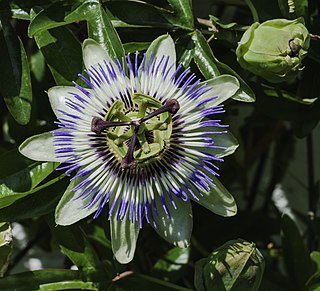
Passiflora caerulea, the blue passionflower, bluecrown passionflower or common passion flower, is a species of flowering plant native to South America. It has been introduced elsewhere. It is a vigorous, deciduous or semi-evergreen tendril bearing vine growing to 10 m (33 ft) or more. Its leaves are palmately lobed, and its fragrant flowers are blue-white with a prominent fringe of coronal filaments in bands of blue, white, yellow, and brown. The ovoid orange fruit, growing to 6 cm (2 in), is edible, but is variously described as having a bland, undesirable, or insipid taste. In South America, the plant is known for its medicinal properties, and is used by both the Toba and the Maka peoples.
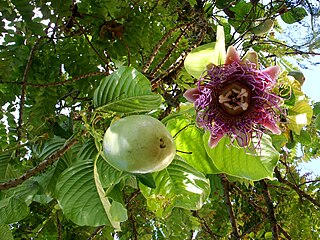
Passiflora quadrangularis, the giant granadilla, barbadine (Trinidad), grenadine (Haiti), giant tumbo or badea, is a species of plant in the family Passifloraceae. It produces the largest fruit of any species within the genus Passiflora. It is a perennial climber native to the Neotropics.

Passiflora incarnata, commonly known as maypop, purple passionflower, true passionflower, wild apricot, and wild passion vine, is a fast-growing perennial vine with climbing or trailing stems. A member of the passionflower genus Passiflora, the maypop has large, intricate flowers with prominent styles and stamens. One of the hardiest species of passionflower, it is both found as a wildflower in the southern United States and in cultivation for its fruit and striking bluish purple blooms.
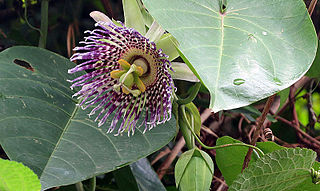
Passiflora ligularis, commonly known as the sweet granadilla or grenadia, is a plant species in the genus Passiflora. It is known as granadilla in Bolivia, Colombia, Nicaragua, Costa Rica, Ecuador, Mexico, The Azores, South Africa, and Peru, granadilla común in Guatemala, granadilla de China or parcha dulce in Venezuela, maracuja doce in Brazil, and granaditta in Jamaica.
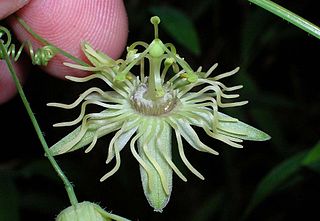
Passiflora lutea, commonly known as yellow passionflower, is a flowering perennial vine in the family Passifloraceae, native to the central and eastern United States. The vine has three-lobed leaves and small, yellowish-green, fringed flowers that appear in the summer, followed by green fruit that turn almost black at maturity. It grows in moist to wet habitats.
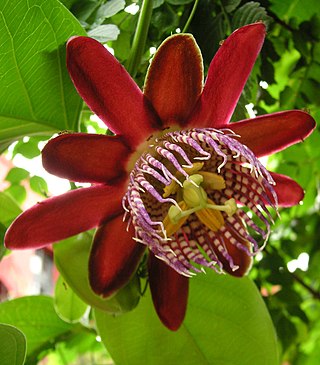
Passiflora alata, the winged-stem passion flower, is a species of flowering plant. It is an evergreen vine, growing to 6 m (20 ft) or more, which bears an edible type of passion fruit. It is native to the Amazon, from Peru to eastern Brazil.

Passiflora actinia, also known as the sea anemone passion flower is a species of passion flower (passionfruit) of the Passifloraceae. It flowers mainly in early spring, producing white, mauve (purple), and blue flowers about 9 cm wide.
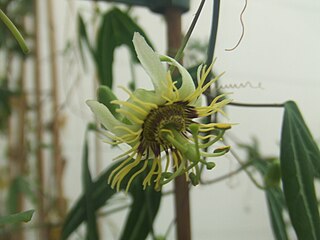
Passiflora xishuangbannaensis is a passion flower vine in the genus Passiflora that is endemic to Yunnan, China. It is a glabrous, 1–3 metres (3–10 ft) long vine with strongly two-lobed leaves. The green and yellow flowers are 3.2–3.8 centimetres in diameter when fully open, one or two flowers per node. It grows in wet and open sunny or shaded areas at 1,200 metres (3,900 ft). It was described in 2005 by Shawn E. Krosnick.

Passiflora nitida, the bell apple, is a tasty, but relatively unknown passion fruit. It is similar to P. laurifolia, with orange-yellow fruits that have a sweet, succulent pulp. It is a fast-growing tropical vine. Its flowers are blue and red, a bit like P. laurifolia and P. quadrangularis. The fruits grow up to 4 centimetres (1.6 in). The exact hardiness in unknown, but it is tropical and should be protected from prolonged temperatures below 50–55 °F (10–13 °C). It is not frost hardy. Passiflora nitida is the cousin of almost all the Passiflora species like P. actinia, P. flavicarpa, P. loefgrenii and so on. Its propagation is by seeds. The fruits are eaten fresh and reportedly quite good in flavor. The bell apple is a native to the Amazon jungle region. Passiflora nitida is also a useful fruit in a drink called Purple Passion. Passiflora nitida has one of the widest geographic ranges. It grows in the tropical lowlands from Costa Rica in the north and French Guiana in the northeast, through wide parts of Brazil.

Passiflora loefgrenii, the garlic passion fruit, is a passion flower first formally described in 1997 by Fabio Augusto Vitta. The plant is named after Albert Löfgren, the first known collector.
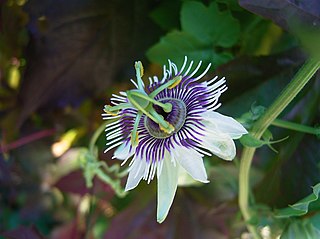
Passiflora morifolia, the blue sweet calabash or woodland passionflower, is a twiner, white and purple flowered passion flower with blue or purple fruit. The very fast-growing vine that can grow a few dozen feet in a season. Flowers are ornate, white, blue and purple fruits follow, which ripen to blue or purple. The orange pulp is edible, but not particularly flavoursome. The hardiness of P. morifolia is to at least 32 °F (0 °C), some sources claim as low as 15 to 20 °F. It grows well in full sun or filtered sun. The vine is fast growing and once established it is quite vigorous. Its propagation is by seed or by cuttings. It is grown as an ornamental. It is not cultivated for its fruit. It is native to the parts of Central and South America.

Passiflora coriacea, commonly known as the wild sweet calabash or bat leaved passion flower, is a tropical vine with very distinct leaves in the shape of bats' wings. It also has purple oval or circle shaped fruit that are mainly ornamental. It is a fast-growing vine to several feet. Leaves are dark green and often with splotches of light-green. White-yellow flowers with the typically ornate Passiflora appearance form when weather is warm.
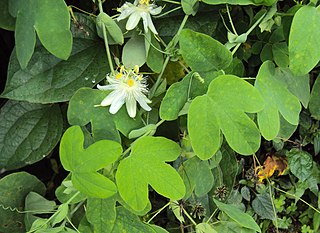
Passiflora subpeltata, commonly known as white passionflower, is a passion flower bearing yellow-green fruits. It is a vining plant with three-lobed leaves and 2-3 ornate flowers. It is grown as an ornamental plant. This vine is also a marginal pest in areas.

Passiflora suberosa is a species of passionflower that is native to the Americas. It is commonly known as corkystem passionflower due to the corkiness of older stems. Other common names include corky passion vine, cork-bark passion flower, corkstem passionflower and corky passionfruit. In Latin America it is called Meloncillo. It is possibly also cryptic and have multiple species in one.

Passiflora guatemalensis, the Guatemala passion vine, is a species in the family Passifloraceae. It is native to Guatemala, and found from southern Mexico through Central America to Venezuela.



















